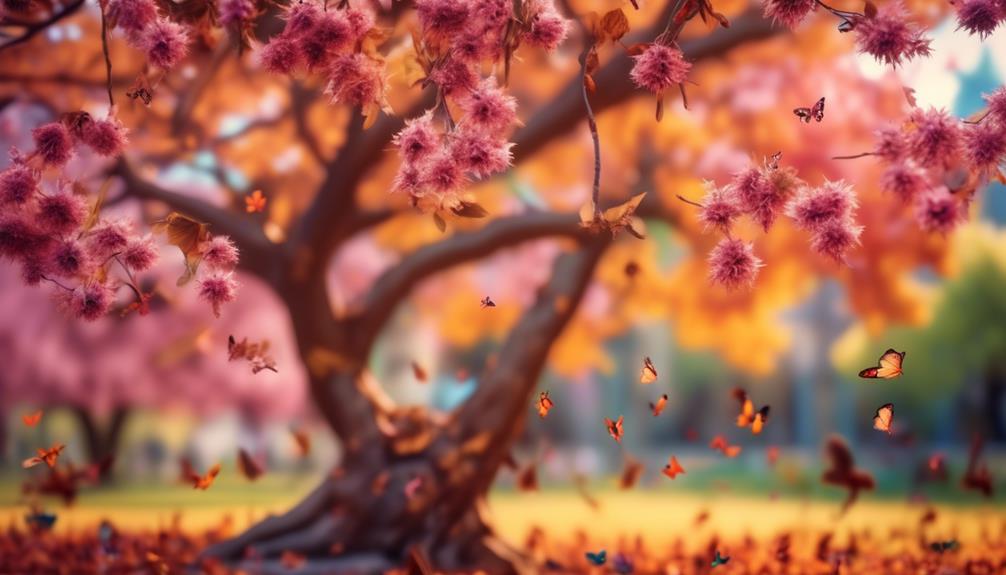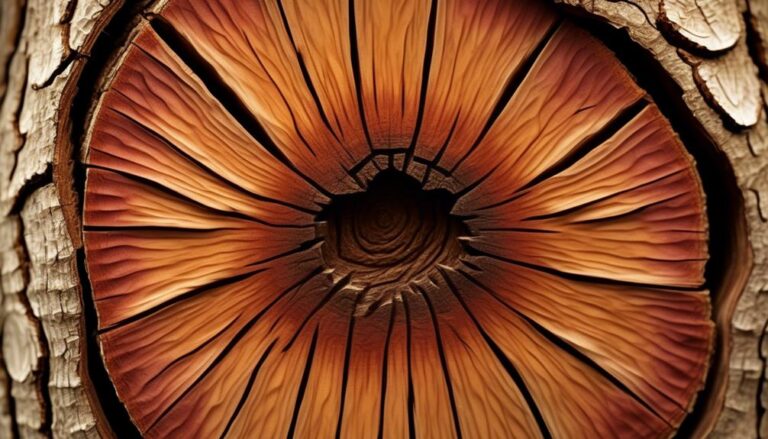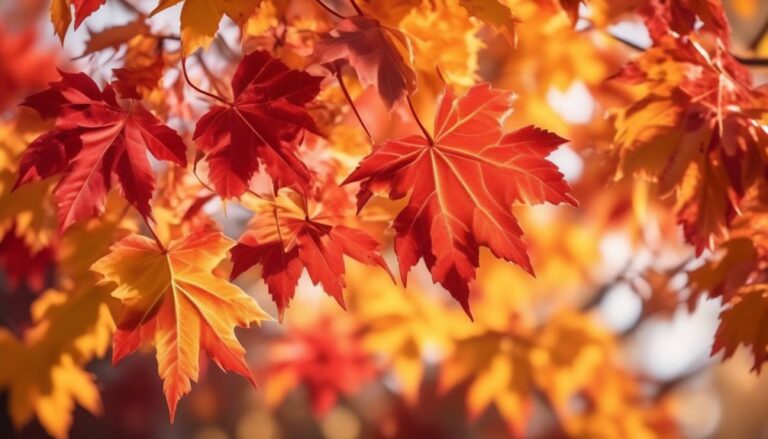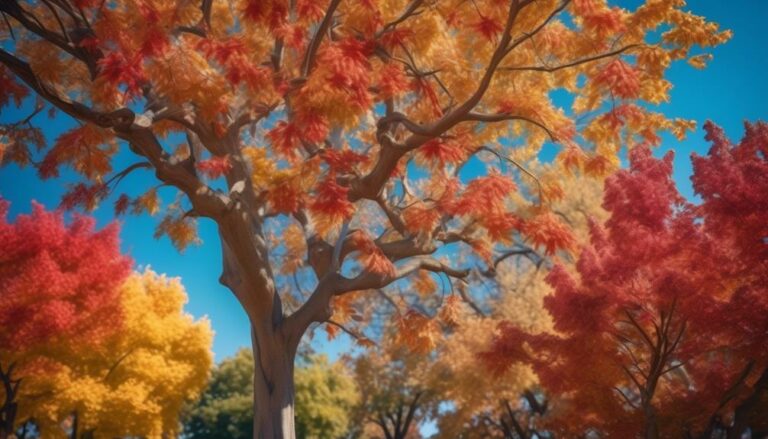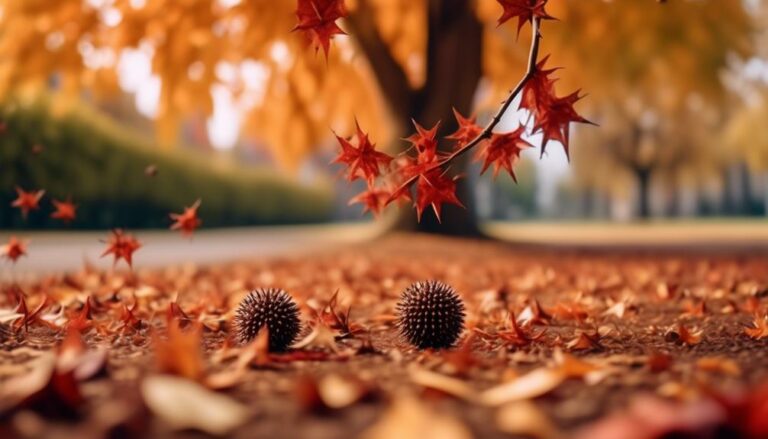What Attracts Wildlife to Liquidambar Trees?
If you've ever seen a Liquidambar tree in full bloom, you might think it's a wildlife magnet of epic proportions. And you wouldn't be far off! These majestic trees have a way of attracting all sorts of creatures, from birds to small mammals.
But what exactly is it about Liquidambar trees that make them so irresistible to wildlife?
Well, my friend, get ready to uncover the secrets of nature's allure as we delve into the fascinating world of Liquidambar trees and the wildlife they attract.
Native Habitat and Adaptation
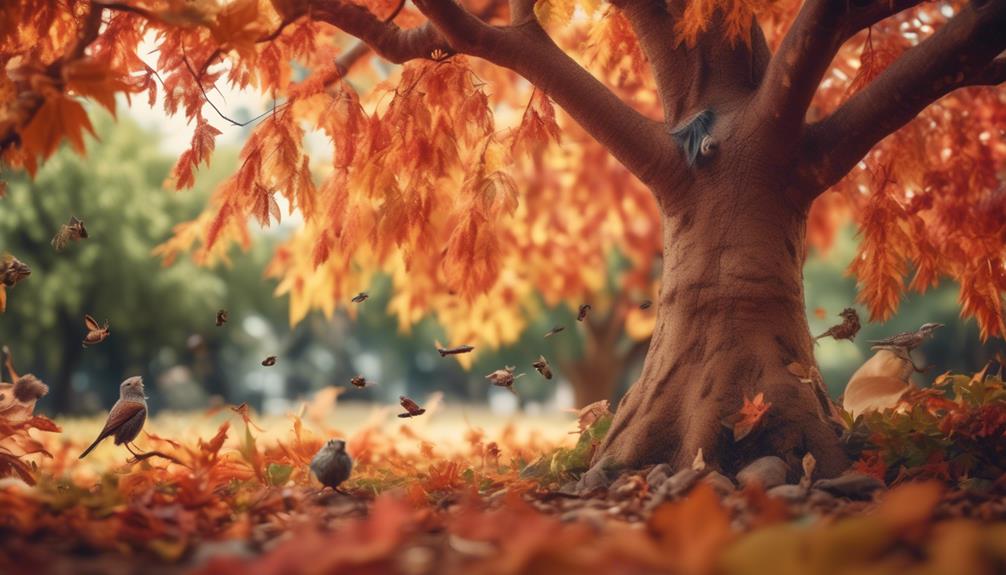
What makes liquidambar trees well adapted to their native habitats?
As a native plant, liquidambar trees have evolved to thrive in their specific environments. These trees can be found in warm temperate areas of eastern North America and tropical montane regions of Mexico and Central America.
One key adaptation of liquidambar trees is their ability to grow in a variety of soil types, including clay and sandy soils. This flexibility allows them to establish themselves in different locations and ensures their survival.
In addition, liquidambar trees provide essential nesting sites and cover for a wide range of wildlife, including birds and small mammals. This makes them an attractive option for these creatures, as they offer both protection and a reliable food source.
Abundance of Food Sources
Are you curious about how sweetgum trees attract wildlife with their abundance of food sources?
These trees provide a variety of options for animals, from the seed pods that entice birds and fruit-eating mammals to the gumballs that scatter across the ground, serving as a food source.
American goldfinches even rely on the sweetgum tree's seeds during the winter months.
Additionally, small birds explore the fruits for invertebrates, making the tree a hub of food activity.
Food Availability
Liquidambar trees provide an abundance of food sources for wildlife. They attract birds and small mammals with their spherical, spiny fruiting heads and hard, bristly fruiting capsules. These trees produce gumballs, which can be found littering the ground from December to April. These gumballs serve as a delicious food source for various wildlife species.
Additionally, the female flowers of the Liquidambar tree give way to hard, beak-shaped, bristly fruiting capsules that provide a consistent food supply. The seed pods from these trees are particularly enticing to several bird species and fruit-eating mammals. This diverse range of food availability makes Liquidambar trees a preferred destination for wildlife seeking sustenance.
Whether it's Imperial Moth larvae, Hickory Horndevil larvae, or American goldfinches, these trees offer a variety of food sources that attract and support a flourishing ecosystem.
Natural Attractions
With their abundant fruit and seeds, Liquidambar trees naturally attract a diverse range of wildlife, providing a haven of food sources for birds and small mammals.
The spherical, spiny fruiting heads, also known as gumballs, are a valuable food source for various species such as goldfinches, sparrows, and chipmunks. These gumballs serve as a nutritious and readily available food option throughout the year.
Additionally, the Sweetgum tree supports the larvae of Imperial Moths and Hickory Horndevils, which further contributes to the biodiversity of the ecosystem.
The presence of Liquidambar trees also offers nesting sites and cover for birds, making them an essential habitat for avian wildlife.
Furthermore, the aromatic gum that exudes from wounds on the tree attracts moths and other pollinators, adding to the already abundant food sources for wildlife.
In addition to their striking fall colors and beautiful flowers, Liquidambar trees provide a rich and varied food supply, making them highly attractive to wildlife.
Nectar-Rich Flowers
Nectar-rich flowers of Liquidambar trees attract a diverse range of wildlife, providing an abundant food source for birds, small mammals, and insects.
Here's why these nectar-rich flowers are so appealing to wildlife:
- A buffet of nectar: Liquidambar trees produce nectar-rich flowers that act as a virtual buffet for wildlife. The sweet nectar serves as a vital energy source for birds, small mammals, and insects.
- A gathering place for pollinators: The yellow-green flowers of Liquidambar trees are like beacons, attracting a variety of pollinators such as bees, butterflies, and moths. These creatures visit the flowers to drink nectar and inadvertently transfer pollen from one flower to another, aiding in the tree's reproduction.
- A feast for the eyes: Liquidambar trees' star-shaped leaves aren't only visually appealing but also serve as landing pads for insects. This makes it easy for them to access the nectar-rich flowers, ensuring a steady stream of wildlife visiting the tree.
With their nectar-rich flowers, Liquidambar trees provide a haven for wildlife, supporting biodiversity and enhancing the overall health of the ecosystem.
Shelter and Nesting Opportunities
Did you know that sweetgum trees offer more than just food for wildlife? These majestic trees also provide shelter and nesting opportunities.
The tree cavities are perfect for birds to build their nests, while the dense foliage provides excellent concealment and protection.
Tree Cavities for Nesting
Tree cavities in liquidambar trees provide essential shelter and nesting opportunities for a diverse array of wildlife, enhancing the surrounding environment and contributing to the natural ecosystem. Here are three reasons why tree cavities are so important for wildlife:
- Nesting Sites: Tree cavities serve as safe and secure nesting sites for various species of birds and small mammals. These cozy spaces protect eggs and young from predators, harsh weather conditions, and provide a comfortable environment for raising offspring.
- Cover and Protection: Wildlife seeks refuge in tree cavities to escape predators or find shelter from extreme temperatures. The hollowed spaces offer a natural hiding spot, shielding animals from danger and providing a sense of security.
- Biodiversity Support: Liquidambar trees with cavities attract a wide range of wildlife, enriching the surrounding ecosystem's biodiversity. Birds and small mammals that use these cavities contribute to the pollination of female flowers and the dispersal of bristly fruiting bodies, aiding in the tree's reproduction and dispersal.
Tree cavities in liquidambar trees play a vital role in supporting wildlife populations and maintaining a healthy ecosystem.
Foliage for Concealment
As we move from discussing the importance of tree cavities for nesting to exploring the next vital aspect of liquidambar trees, let's now turn our attention to the role of foliage in providing concealment and nesting opportunities for a diverse range of wildlife.
The deep green leaves of the Liquidambar, also known as the Sweet Gum tree, create a dense and lush canopy that serves as a perfect hiding spot for animals seeking shelter. The thick foliage offers protection from predators and creates a secluded environment suitable for nesting and hiding.
The fullness of the tree's canopy, combined with its rapid growth rate, makes it an attractive option for wildlife in search of concealment. The foliage of Liquidambar trees provides a safe and secure habitat for wildlife seeking shelter and nesting opportunities.
Attraction to Fragrance and Aroma

The irresistible fragrance and aroma emitted by liquidambar trees make them a magnet for a diverse array of wildlife. Here's why these fragrant trees are so appealing:
- Fragrant Leaves: When the leaves of liquidambar trees are bruised, they release a sweet, aromatic scent that attracts wildlife. This fragrance acts as a natural lure, drawing in a variety of animals.
- Attraction for Birds and Small Mammals: The alluring fragrance from liquidambar trees can attract birds like goldfinches, as well as small mammals. These animals are enticed by the scent, which provides them with a potential food source and nesting sites.
- Appeal to Insects: Liquidambar trees also emit an aromatic gum from wounds, which can be appealing to certain insects and moths. The fragrance acts as a signal, inviting these creatures to explore and potentially find a suitable habitat.
The fragrant nature of liquidambar trees contributes to their economic and ecological importance, making them valuable to the environment and wildlife.
Unique Bark and Trunk Characteristics
You'll be amazed by the unique bark and trunk characteristics of Liquidambar trees. Their deeply furrowed and rough bark adds a touch of ruggedness to your landscape, while the corky projections on their branches provide interesting texture.
And let's not forget about those spherical, spiny fruiting heads known as gumballs that give these trees their distinctive look. These features not only make Liquidambar trees visually appealing, but they also play a role in attracting wildlife to your garden.
Bark and Trunk Features
With its rough and deeply furrowed bark, the liquidambar tree adds a touch of texture and visual interest to its trunk, making it a standout feature in any landscape. Here are some unique bark and trunk features of this tree that you might find fascinating:
- The trunk can develop corky projections on branches, creating unique and distinctive features.
- The deep orange, red, and yellow leaves in fall make the trunk stand out with a vibrant backdrop.
- Sweetgum trees have a straight trunk and conical crown, giving them a stately and imposing appearance.
These bark and trunk features make the liquidambar tree a great addition to your yard, providing not only aesthetic appeal but also attracting a wide range of wildlife.
Wildlife Attraction Factors
As we explore the wildlife attraction factors of liquidambar trees, let's now turn our attention to the unique bark and trunk characteristics that play a crucial role in drawing various creatures to these magnificent trees.
The deeply furrowed and rough bark of liquidambar trees is particularly enticing to wildlife. Beavers, mice, and rabbits are attracted to the clusters of bark for feeding and nesting purposes. Additionally, the bark provides nesting sites and cover for birds and small mammals, contributing to the biodiversity of the ecosystem.
The distinctive bark and trunk of the liquidambar tree grow relatively quickly, making it an ideal habitat and food source for a wide range of wildlife, including goldfinches, sparrows, and chipmunks.
Not only do the attractive bark and unique trunk characteristics add beauty and liveliness to the surroundings, but they also make liquidambar trees a resilient and appealing option for wildlife habitat and landscape enhancement.
Seasonal Color Changes
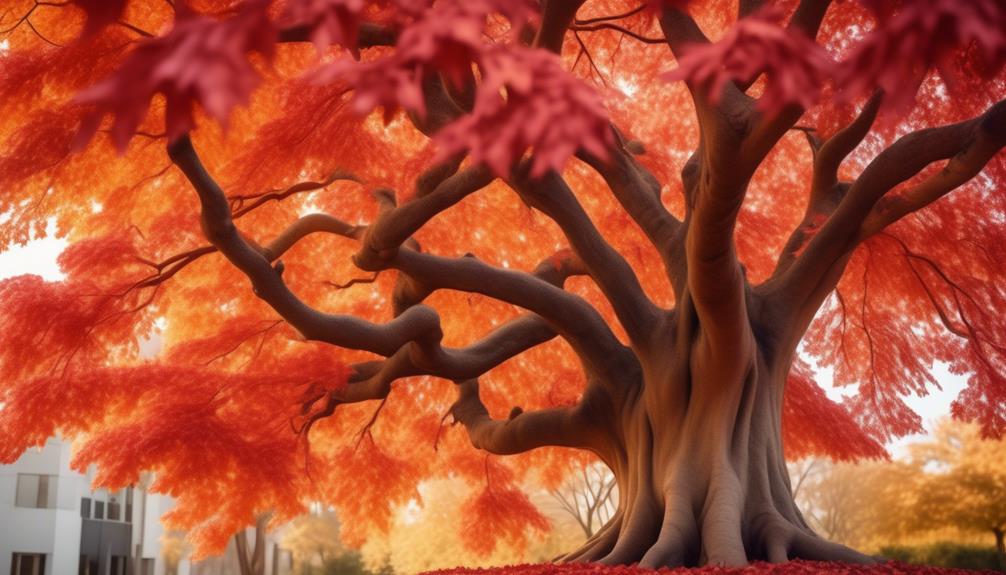
The Liquidambar tree's seasonal color changes bring vibrant hues of red, purple, yellow, or orange to its glossy, star-shaped leaves in the fall, attracting a variety of wildlife to your garden.
Here are some fascinating facts about the seasonal color changes of the Liquidambar tree:
- The tree's leaves turn into a brilliant mixture of yellows, reds, purples, and oranges, creating a stunning visual display in your garden.
- The small yellow-green flowers in spring develop into spherical clusters of spiny fruiting heads known as gumballs, which add an interesting texture to the tree's fall foliage.
- These colorful leaves and the spherical clusters of gumballs provide a rich food source for wildlife. American goldfinches, for example, feast on the seeds during winter, while small birds search for invertebrates inside the fruits.
- The seasonal color changes of the Liquidambar tree not only attract wildlife but also provide nesting sites and cover for birds and other animals.
With its vibrant colors and abundant food sources, the Liquidambar tree's seasonal color changes are sure to make your garden a haven for wildlife.
Leaf Structure and Texture
Glossy and star-shaped with toothed margins and pointed lobes, the leaves of Liquidambar trees add a distinctive texture to their vibrant foliage. The leaf structure and texture of Liquidambar trees contribute to their unique appearance. The leaves are smooth and glossy, catching the light and creating a shimmering effect. Their star-shaped lobes and toothed margins give them an interesting and visually appealing look.
In addition to the leaves, Liquidambar trees produce hard, spherical clusters known as gumballs. These bristly fruiting clusters litter the ground from December to April, adding another texture to the tree and its surroundings. The combination of smooth and glossy leaves, along with the presence of these spherical clusters, creates a textured landscape that attracts wildlife to Liquidambar trees.
Importance of Liquidambar in the Ecosystem

Attracting a variety of wildlife and contributing to biodiversity, Liquidambar trees play a crucial role in the ecosystem. Here are some reasons why these trees are so important:
- Wildlife habitat: Liquidambar trees provide nesting sites and cover for birds and other wildlife, creating a diverse habitat that supports a wide range of species.
- Food source: The fruit produced by Liquidambar trees serves as an important food source for birds and wildlife, enhancing the overall wildlife habitat and contributing to the ecosystem's food web.
- Environmental benefits: Besides attracting wildlife, Liquidambar trees offer environmental services such as carbon dioxide sequestration and stormwater runoff avoidance. They also release a fragrant scent when bruised, adding to the sensory experience of the ecosystem.
- Shade tree: Liquidambar trees provide shade, reducing the temperature in urban areas and creating a more comfortable environment for humans and wildlife alike.
With their ability to support wildlife, provide food, and offer environmental benefits, Liquidambar trees are an essential component of a healthy and thriving ecosystem.
Role in Supporting Pollinators
Supporting a vibrant ecosystem and contributing to the health of surrounding plant life, Liquidambar trees play a crucial role in nourishing a diverse range of pollinators. With their small yellow-green flowers that cluster together in spherical clusters, these trees provide a valuable food source for pollinators such as bees, butterflies, and moths.
The nectar and pollen produced by the flowers attract and nourish these pollinators, aiding in their survival and contributing to the pollination of other plants in the area. By supporting a diverse range of pollinators, Liquidambar trees help to maintain the ecosystem's biodiversity and the health of surrounding plant life.
Furthermore, their presence indirectly benefits various wildlife species by supporting the production of fruits and seeds. The abundance of Liquidambar trees in an area can also contribute to the overall health and abundance of pollinator populations, which in turn aids in the pollination of nearby crops and plants.
Wildlife Interactions and Observations
The presence of Liquidambar trees in an area creates a vibrant ecosystem that attracts a diverse array of wildlife, fostering fascinating interactions and providing ample opportunities for observation. Here are some interesting wildlife interactions and observations that can be observed around Liquidambar trees:
- Birdwatching: Liquidambar trees are known to attract various bird species, such as songbirds and migratory birds. These birds are drawn to the tree for its seed pods, which provide a valuable food source. Observing the different species of birds that visit the tree can be a delightful experience.
- Squirrel antics: Liquidambar trees produce spiked fruit balls that appear in spherical clusters. These fruit balls are a favorite snack for squirrels, who can be seen climbing the tree and playfully chasing each other as they collect the fruits. Watching their acrobatic maneuvers can be highly entertaining.
- Insect exploration: Liquidambar trees support a diverse range of insects, including moths and pollinators. Observing these insects as they interact with the tree's flowers and foliage can provide valuable insights into their behavior and role in the ecosystem.
The wildlife interactions and observations around Liquidambar trees offer a fascinating glimpse into the interconnectedness of nature and highlight the importance of these deciduous trees in supporting local biodiversity.
Conclusion
So, if you're looking to attract wildlife to your yard, consider planting a liquidambar tree!
With its abundance of food sources, shelter and nesting opportunities, attractive fragrance, unique bark and trunk characteristics, and supportive role in the ecosystem, it's no wonder that wildlife can't resist these beautiful trees.
Plus, the minor nuisances, like the litter from the fruit pods, are easily outweighed by the benefits.
So go ahead, invite some furry and feathered friends to your yard with a liquidambar tree!

